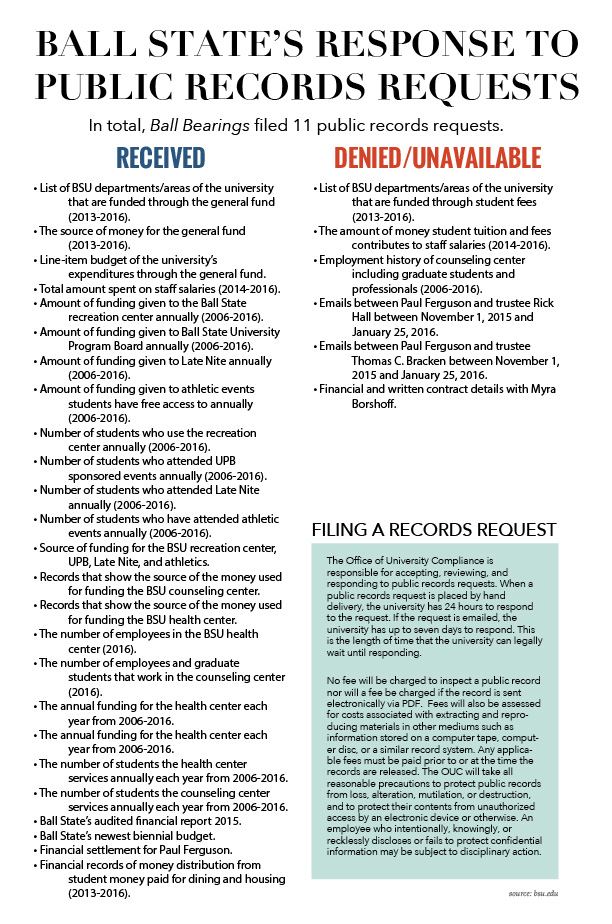Since November 2015, I have searched for the answer to one question: Where does our tuition money go?
The process was slow, and each time I found a small piece of the puzzle, I only had more questions that followed. When a public records request was placed, the university dragged out the process for 24 hours if the request was delivered in person, or up to seven days if the request was emailed. This is the length of time that the university could legally wait until responding.
However, the responses were usually not the answer to my question. Had they given me the information I had asked for, this wait would have been reasonable. Unfortunately, the first reply was always an acknowledgement of my request, usually followed by a request for clarification. Then, I would wait several days to several weeks to get the answer to my question.
In total, I filed seven public records requests, under the Indiana Access to Public Records Act. I filed these using the form the university provides. These requests were in attempt to figure out where your money is being spent. The University successfully answered four of the requests, and partially answered one more. Our request for the amount of money the counseling center receives and the number of employees who work there was initially denied. With rewording of that request, it was eventually fulfilled.
But the fact that our requests were eventually fulfilled does not tell the story of how difficult it is for anyone in the general public to find out exactly where Ball State is getting – and spending – its money.
* * *
I knew student tuition and fees contributed to Ball State University’s general fund, which is used to run 150 areas of the university, including the office of the president. I scoured the Ball State audit reports, but the general fund was only mentioned a single time in the most recent audit from 2014, and even then, the total amount was not included.
The report stated one percent – or $3.4 million – was set aside for incidentals and unforeseen circumstances. I did the math, and figured the general fund totaled around $337 million.
However, reporters can’t just “do the math.” I needed someone to confirm that number, and to tell me how much money was in this year’s fund. I assumed this was a simple request. On March 1st, I visited the administration building to ask my question: How much money makes up the general fund?
That single question turned into a lesson in ambiguity.
I first tried the budget office. But a sign on the door stated only employees could enter. All others were directed to the business affairs office, so that’s where I went. From there was directed to the budget office from within the business affairs office. I walked up the narrow staircase to a carpeted hallway, to the right of which, a woman sat at a desk. She was surprised. The business affairs office usually calls her before letting someone up, she said. She didn’t clarify why, and I wasn’t there to find that out. Instead, I asked her my question about the general fund. She fumbled her words, but never answered. Instead, she told me to file another public records request and asked me to leave – she said she couldn’t answer my question.
This was my sixth records request about the financing of Ball State. And it would not be the last.
* * *
I spent five months investigating how student tuition is allocated and where Ball State University receives its funding. Despite claims of transparency, I was only able to touch on the answers to those two questions.
And there are still so many questions left unanswered. No one can speak about how student tuition is used at the university, for instance. I can’t tell you exactly how the money is dispersed. I tried. I filed seven formal requests asking questions about multiple aspects of the university financing, such as the amount of money in the general fund, where that money comes from, and what areas of the university it controls. When I made the request for a list of the revenue sources that make up the general fund, I received a phone call asking me to clarify what I was asking for because they said they didn’t understand.
The process is a dance that favors the university. I had to guess the correct keywords when writing requests. If I guessed incorrectly, the process was prolonged. When I tried to get university personnel to answer my questions, they often responded like the woman in the administration building did: telling me to file a public records request.
Uncovering how the university budget works is a tedious, drawn-out process that makes finding information difficult.
I was able to figure out that student tuition and fees contributed more than $11.4 million of intercollegiate athletics’ $20.6 million budget for the 2014-2015 academic year. Student tuition and fees also contributed $623,581 to the rec center, $121,073 to UPB, and $349,119 to Late Nite that same year.
Ball Bearings’ reporters filed a total of 11 public records requests asking for more than 25 pieces of information ranging from the amount of student money that goes toward staff salaries to emails between former President Ferguson and the Board of Trustees chair, Rick Hall. Both of these requests were denied because they said they could not provide that information or, in the case of the emails, because it was “not reasonably particular.”
In regard to searching for where student tuition goes, I contacted six different university departments – the office of institutional effectiveness, the counseling center, the health center, the budget office, housing and residence life, and the library. The counseling center never responded to me, and the others told me to try somewhere else because they couldn’t help me either.
Through this process, I was only able to speak with one person on the record – a representative from the health center – despite the dozens of emails and phone calls I made to other departments.
Transparency has been discussed this semester in response to former President Ferguson’s resignation by both faculty and students. But there is a lack of transparency in other areas of Ball State – how student money is used being one of them.
No where on the Ball State website can a student find how his or her money is allocated, or how much revenue Ball State takes in from student tuition and fees. Although there is an entire page dedicated to financial transparency, these questions are not found online, cannot be answered by staff, and cannot be found easily through filing public records requests.
Students should not have to wonder what Ball State does with the thousands of dollars they pay in tuition and fees. The price of college keeps going up. Students keep paying more, are taking on more debt, and still don’t know how their money is being spent.
Your money matters. But we still don’t know where it all goes.
On April 13, we will meet with Acting President Terry King and Vice President of Business Affairs Bernard Hannon to answer your questions about where your money goes. Everyone is welcome, but space is limited. Tell us if you’re attending on Facebook and share your questions on Twitter using #MyMoneyBSU.





